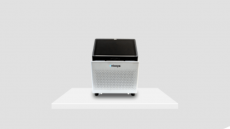MilliporeSigma: Filling gaps in continuous bioprocessing will lower COGS

“In a highly regulated industry any new technology or significant shift in operating mode change requires a robust set of demonstrated technologies and the regulatory support required for implementation,” Merrilee Whitney, head of Next-Generation Bioprocessing, Life Science at Merck (known as MilliporeSigma in North America).
Speaking with Biopharma-Reporter ahead of the Interphex convention in New York, she said realising the commercial potential of fully continuous manufacturing for biopharmaceuticals through increased flexibility and lower operational costs – like the introduction of single-use technologies before it – takes time and innovation.
“The achievement of fully continuous processing will be an evolution as the industry adopts and learns process intensification technologies and applications where their bottlenecks exist today and grow over time into a fully connected, fully continuous process.”
75% drop in COGS
Whitney will be part of a panel in New York discussing the subject further, but for now she described process intensification as the forerunner of continuous manufacturing and having significant impact of cost of goods sold (COGS).
“For instance, one customer reported a 75 percent reduction in COGS,” she told us, adding “COGS will continue to fall as we operate our process in connect and continuous modes.”
The adoption across multiple scales of MAb templates has been shown to be highly effective through technologies such as Single Pass TFF (SPTFF) and the move to upstream intensification via perfusion. These technologies have helped reduce facility size and allow market demand to be met in 2,000L single-use bioreactors, she argued.
Scale-up, sensors and regulators
But there are many gaps which still need to be filled in this space.
“Scale is one major area right now where there will need to be clearly demonstrated scale up strategies and data to support. Additionally, single-use sensing technologies and analytical tools which will enable real time release still require some development across the entire process,” Whitney said.
“Finally, there are still many regulatory questions which will need to be answered in terms of validation strategies where connected processes are concerned.”
Plugging the gaps
According to Whitney, while firms like hers are developing technologies to address gaps in the continuous process – especially in software and automation, in MilliporeSigma’s case – there is no single way a supplier will solve all the adoption challenges.
“They will need to be filled through a triad of internal development, business development, and collaborations with regulators and industry alike,” she said.
But she remained confident the gaps will be filled, as adoption is being driven by all sides.
“The industry and end-users see the significant cost and efficiency benefits that can be gained with process intensification. Regulators see the improved quality that comes through the implementation of QbD and the digital tools to enable next generation processes.
“Finally, suppliers like Merck are looking to solve these challenging problems to help the industry make life-enhancing and life-saving therapies more broadly and more affordably accessible to a worldwide patient population.”


















